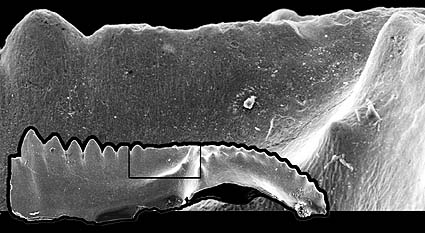

Left: Patterns of recurrent damage and surface wear in conodonts, all P1 elements of Idiognathodus. Above: Recurrent damage on dorsal blades resulting from occlusion and use in feeding during life. In this example repeated damage has reduced the denticulate area at the occlusal (dorsal) end of the blade to a flat ridge. Surface damage is also evident. Royal Ontario Museum specimen ROM 49779 from Upper Carboniferous, Elk County, Kansas, USA. Modified from Donoghue and Purnell (Donoghue, P. C. J. and Purnell, M. A. (1999a) ‘Growth, function, and the conodont fossil record’, Geology, 27(3), 251-254). Terms for orientation and conodont element notation follow Purnell et al. (Purnell, M. A., Donoghue, P. C. J. and Aldridge, R. J. (2000) ‘Orientation and anatomical notation in conodonts’, Journal of Paleontology, 74(1), in press.)